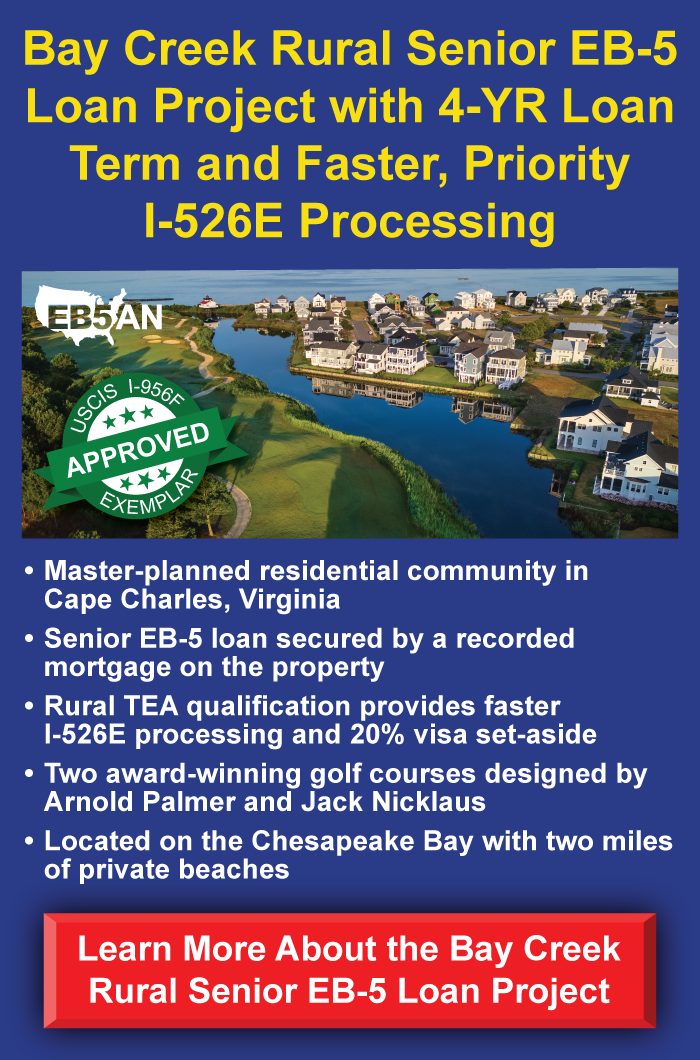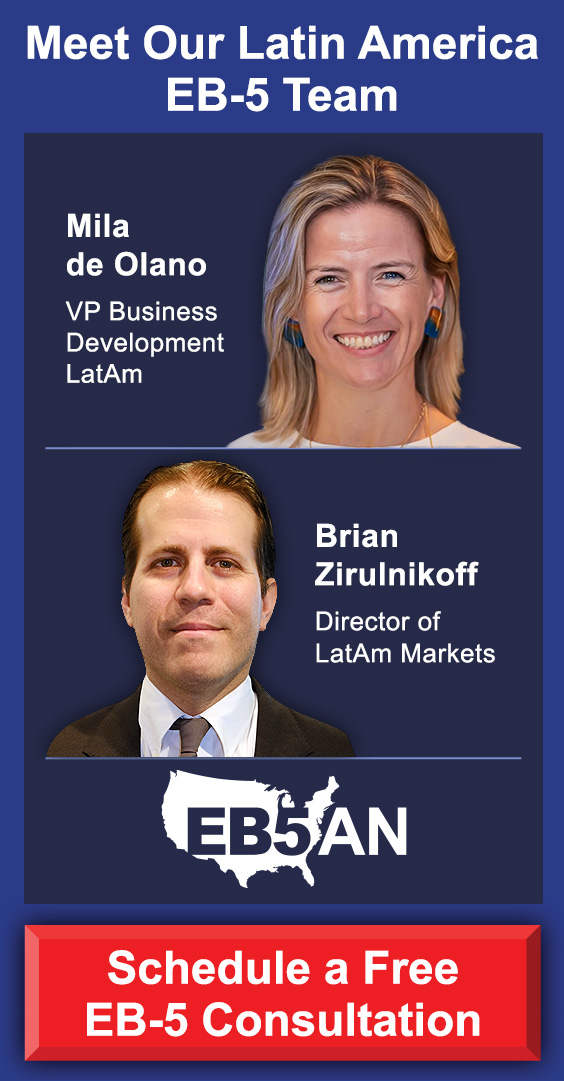USCIS’s changes to the minimum EB-5 investment period, and the recent outcome of the IIUSA lawsuit against this new policy, have drawn the attention of EB-5 investors to one basic question: When will they get their money back?
In addition to the immigration benefits that motivate EB-5 investors, an EB-5 investment can potentially result in a full repayment of their funds—and even in accrued returns.
But when exactly can EB-5 investors expect to get their funds back?
Regardless of the two-year minimum investment period set by USCIS, the timing of an EB-5 investor’s repayment is ultimately determined by the specific terms of the investment.
“It’s important for investors to distinguish between the minimum sustainment period and the actual timing of repayment,” points out Sam Silverman, managing partner of EB5AN. “Before investing, EB-5 applicants should study the repayment terms in the offering documents and make an informed decision.”
If you’ve already made an EB-5 investment or are planning to do so, you likely want to find out the timeline for your project’s repayment.
In this post, we provide a detailed guide to determining when you could be repaid according to the investment terms of your EB-5 project. This information will enable you to plan accordingly and find out the approximate duration of your EB-5 investment.
The Flow of EB-5 Funds
The Two-Year Minimum Sustainment Periods
When Will EB-5 Investors Be Repaid?
Get a Timely Repayment With EB5AN
The Flow of EB-5 Funds
Let’s begin by examining how EB-5 capital flows from investors to EB-5 projects and eventually back to EB-5 investors. Throughout this discussion, we’ll also introduce several key concepts and participants involved in the EB-5 process.
An EB-5 investor begins by wiring the investment amount ($800,000 for projects in a targeted employment area (TEA) or $1,050,000 for non-TEA projects) to an escrow account established by the regional center’s investment fund. (Regional centers are entities licensed by USCIS to sponsor EB-5 real estate projects and to manage the EB-5 capital associated with them.)
This account is specific to the project, and it is typically held by a third-party bank or trust company to safeguard the funds until certain release conditions are met.
The investment fund created by the regional center for each project is formally known in the EB-5 program as the new commercial enterprise (NCE). These entities are generally structured as limited partnerships (LPs) or limited liability companies (LLCs).
In an LP, EB-5 investors purchase partnership interests and take on the role of limited partners, while in an LLC, they purchase equity interests and become members. The regional center’s principals, meanwhile, act as general partners or managing members, with responsibility for overseeing the NCE’s activities.
Funds leave escrow and are deployed into the project once the terms of the offering documents and the agreements between the NCE and the project entity have been met. The EB-5 project entity that receives the investment capital is called the job-creating entity (JCE). Depending on the structure, the NCE may provide the JCE with a loan or invest in it directly through equity.
As we’ll examine below, the two-year minimum sustainment period begins once the funds are deployed to the JCE.
The repayment of EB-5 funds by the JCE back to the NCE depends on the specific terms of the loan or equity arrangement. In the case of loans, repayment usually occurs at the loan’s maturity, though interest payments may be made during the term. Equity arrangements, on the other hand, may involve periodic distributions of returns proportional to each investor’s ownership interest.
Regardless of the structure, repayment always depends on the financial success of the EB-5 project and its ability to generate sufficient revenue. It is crucial for investors to keep this point in mind as they search for a well-capitalized EB-5 project with a solid business plan.
The exit strategies used to repay EB-5 investors vary across projects. In some cases, repayment may come through the sale of the investor’s interest in the project at fair market value. In others, repayment might occur through cash flows generated by operations or through the sale or refinancing of the business.
If the project succeeds financially, the JCE will meet its repayment obligations, and the NCE will hold the EB-5 investors’ funds, along with any returns accrued.
Then the NCE can repay an investor’s principal as well as any returns.
But how long must the funds remain invested before they can be returned to the EB-5 applicant?
To answer this question, let’s examine USCIS’s current policy for the minimum EB-5 sustainment period.
The Two-Year Minimum Sustainment Period
The current USCIS rule on the EB-5 sustainment period is clear: Investors are required to keep their capital invested for a minimum of two years, beginning when the full amount is made available to the JCE.
This is a departure from the old policy, where sustainment was tied to two years of conditional permanent residence. For investors, this shift allows for shorter, more predictable timelines, particularly in projects structured with early repayment capacity. Once an EB-5 project is financially able to return capital, repayment can occur after the two-year window, regardless of where the investor stands in their immigration process.
Additionally, since job creation is the foundation of the EB-5 program, at least 10 jobs must also have been created using an investor’s EB-5 funds before an investor is repaid.
A recent lawsuit brought by IIUSA, an EB-5 trade association, challenged the new policy, pushing for a longer five-year period and arguing that USCIS had overstepped by announcing the two-year framework without formal rulemaking¬. EB5AN ardently opposed this argument.
Thankfully for EB-5 investors, on July 29, 2025, Judge Ana Reyes of the U.S. District Court for the District of Columbia rejected that position. She held that the EB-5 Reform and Integrity Act of 2022 (RIA) did, in fact, change the statutory language to require only two years of sustainment and that USCIS’s guidance could remain in effect while the agency moves forward with formal rulemaking.
A Notice of Proposed Rulemaking from USCIS is expected later this year, and the two-year sustainment period still applies.
When Will EB-5 Investors Be Repaid?
Investors should note that these two years are only the minimum investment period for an EB-5 offering. An EB-5 investment can remain committed for significantly longer, which brings us back to our main question: When can EB-5 investors expect to be repaid?
Besides the USCIS sustainment policy, three factors ultimately determine the timing of repayment: the EB-5 project’s financial performance, the JCE’s loan or equity agreement with the NCE, and the terms of the LP or LLC between the NCE and individual investors.
Again, the timing of repayment depends on the project’s financial performance. If a project performs well—by generating revenue through operations, asset sales, or refinancing—it can repay the EB-5 loan or equity to the NCE at maturity. But should the project underperform—or lack collateral, dependable cash flow, or refinancing options—there may be no funds available to fulfill the repayment obligations, leaving investors exposed to loss.
Moreover, even when a project is financially viable, its capital structure may place EB-5 investors behind senior lenders. In such cases, repayment is only possible once senior obligations are satisfied.
If a project encounters financial setbacks, repayment may be delayed for months or years—or not take place at all.
The next factor determining when investors are repaid is the agreement between the NCE and the JCE.
In loan-based models, a definitive maturity date is set, outlining the timeline for the repayment of principal and any accrued interest, and may include extension provisions under certain fees or rate adjustments. These agreements typically include representations, warranties, and covenants—both affirmative (e.g.,requiring job creation, financial disclosures, insurance, and tax compliance) and negative (e.g., restrictions on asset sales or additional borrowing)—with clearly outlined default scenarios and potential remedies. A repayment guaranty may be included, through which a financially sound third party pledges to repay the EB-5 loan if the borrower defaults. However, the strength of this protection depends entirely on the guarantor’s capital adequacy and credibility; a weak guarantor provides little real security.
Even after the JCE repays the NCE, when individual investors receive their depends on the offering documents that govern their relationship with the NCE. These documents specify how and when investors are repaid, usually through a redepmtion (a topic covered in more detail below). Offering documents also dictate the release of funds from escrow into the NCE and outline investors’ rights under various scenarios (e.g., early repayment or delayed redemption). Repayment from the NCE to investors may take the form of equity interest, sale of the investor’s interest at fair market value, or through scheduled distributions, depending on the terms agreed in the LP or LLC operating agreement.
Most leading EB-5 firms repay investors through a redemption. Let’s take a look at how the redemption process works in more detail.
In an EB-5 context, redemption works as a structured exchange in which the investor surrenders their ownership interest in the NCE and receives a fixed repayment in return. The process begins with a redemption agreement executed by the investor and the NCE’s general partner. This document not only formalizes the investor’s resignation from the partnership or LLC but also locks in the exact redemption amount and repayment deadline. From this point forward, the NCE is legally bound to complete the repayment under the agreed-upon conditions.
Once the agreement is signed, the “effective date” triggers obligations on both sides. The investor provides resignation documents, confirming that no I-526E petition remains pending. In parallel, the NCE confirms its authority to redeem and specifies the redemption date—the day it must deliver repayment. On that date, the investor’s interest in the NCE is automatically cancelled, the capital account is closed, all future rights to distributions or participation in the entity end, and the repayment amount is wired in full.
To protect both parties, the redemption agreement includes warranties and releases. The investor warrants that their interest is unencumbered and that they have the authority to resign, while the NCE warrants that the agreement is valid and enforceable.
The clarity of a redemption agreement is what makes this repayment mechanism practical in EB-5 projects. By eliminating uncertainty, both the investor and the NCE know in advance exactly what documents, actions, and payments are required. Once the payment is complete, the investor exits cleanly, and the NCE closes its obligations without ongoing exposure.
Get a Timely Repayment With EB5AN
As outlined above, in practice, the timing of an EB-5 investor’s repayment depends on three factors: the project’s financial performance, the agreement between the NCE and JCE, and the contractual terms governing each investor’s relationship with the NCE. Even if a project is successful, repayment cannot occur before these agreements allow it, and the documents set clear conditions that must be satisfied to release funds for repayment.
Notably, investment periods vary widely across EB-5 offerings. Some projects are structured with shorter terms that align with early repayment capacity, while others establish longer periods before funds can be returned. EB5AN recognizes that investors approach the program with different goals, risk tolerances, and liquidity needs. For this reason, we structure offerings with a range of investment horizons to accommodate these differences.
For example, our Bay Creek project is structured with a target investment period of approximately four years, and our Twin Lakes Georgia project has an expected term of five years. Both are rural projects with priority USCIS processing.
In contrast, our Terra Ceia (loan) urban project offers a short investment term of only three years.
Each offering is built with repayment timelines that reflect the project’s business model, financing structure, and market environment. These project structures mean investors can select the project that best fits their individual timeline preferences and financial planning objectives.
As Sam Silverman, managing partner of EB5AN, explains, “One of the most important steps an EB-5 investor can take is to understand the specific investment term of the project they’re choosing. The investment period is not the same in every offering—and it directly affects when repayment can occur. At EB5AN, we are transparent about these terms so investors can align their immigration and financial objectives with the right project.”
To learn more about our projects or to plan your EB-5 investment, schedule a free consultation with EB5AN.
Further Reading
- How EB-5 Investors Get Their Money Back
- How I Got High Returns, Employment Authorization, and a Travel Permit from My EB-5 Investment: Ravi’s Story
- Good News for EB-5 Investors in Urban Projects—Federal Court Upholds Two-Year EB-5 Sustainment Period
- Kolter Repays Funds for EB5AN Saltaire Project
- EB5AN Repays Investors in Its VUE Sarasota EB-5 Project, Marking EB5AN’s Latest EB-5 Project Financial Success







